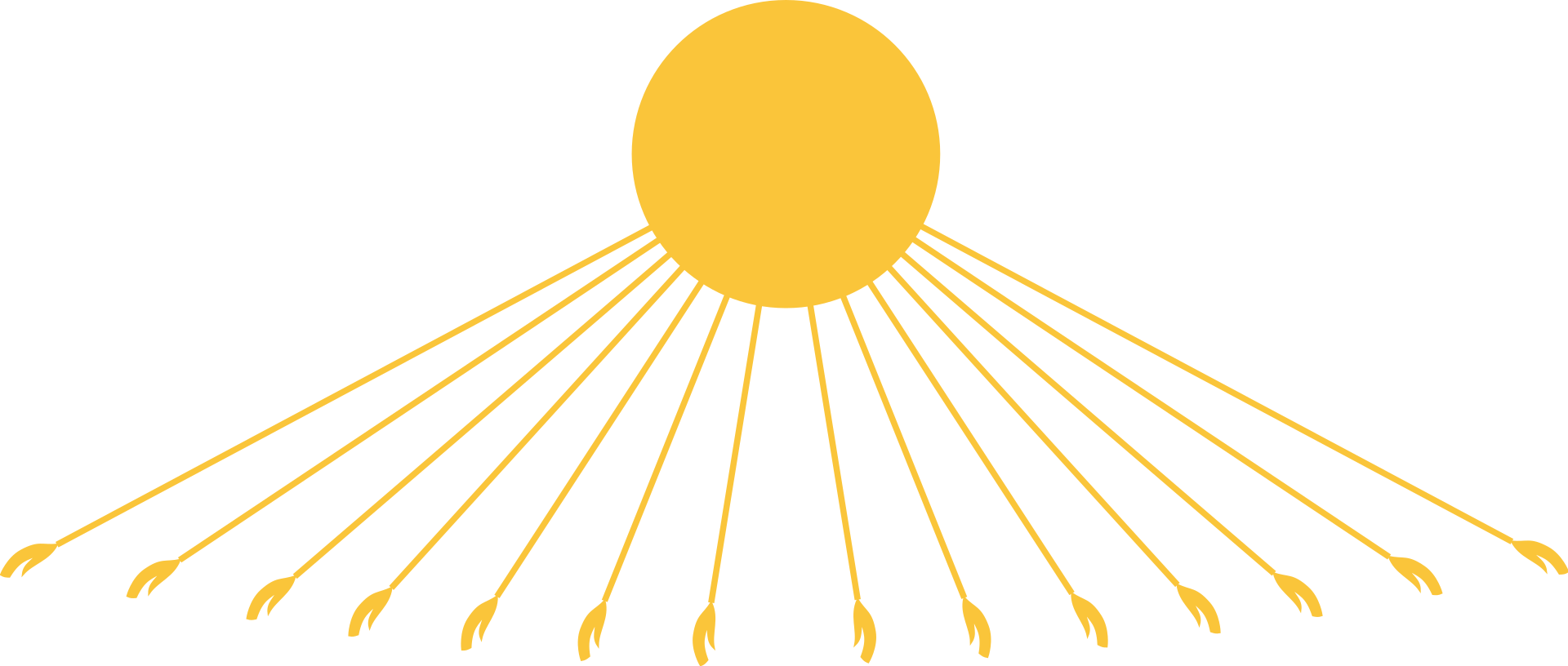
The
symbol of Aten - Sun disc and radiating arms
Aton, in ancient Egyptian religion, a sun god, depicted as the solar disk emitting rays terminating in human hands, whose worship briefly was the state religion. The pharaoh Akhenaton (reigned 1353Ė36 BCE) returned to supremacy of the sun god, with the startling innovation that the Aton was to be the only god (see Re). To remove himself from the preeminent cult of Amon-Re at
Thebes, Akhenaton built the city Akhetaton (now Tell el-Amarna) as the centre for the Atonís worship.
The most important surviving document of the new religion is the Aton Hymn, which was inscribed in several versions in the tombs of Akhetaton. Like some other hymns of its period, the text focuses on the world of nature and the godís beneficent provision for it. The hymn opens with the rising of the sun:
"Men had slept like the dead; now they lift their arms in praise, birds fly, fish leap, plants bloom, and work begins. Aton creates the son in the motherís womb, the seed in men, and has generated all life. He has distinguished the races, their natures, tongues, and skins, and fulfills the needs of all. Aton made the
Nile in Egypt and rain, like a heavenly Nile, in foreign countries. He has a million forms according to the time of day and from where he is seen; yet he is always the same."
The Aten was the disc of the sun and originally an aspect of Ra, the sun god in traditional ancient Egyptian religion. While the Aten was worshiped under the reign of Amenhotep III, it was made the sole deity to receive state and official cult worship under his successor
Akhenaten, though archaeological evidence suggests the closing of the state temples of other Egyptian gods likely did not stop household worship of the traditional pantheon. Inscriptions, such as the Great Hymn to the Aten, found in temples and tombs during Akhenaten's reign showcase the Aten as the creator, giver of life, and nurturing spirit of the world. Aten does not have a creation myth or family but is mentioned in the Book of the Dead. The first known reference to Aten the sun-disk as a deity is in The Story of Sinuhe from the 12th Dynasty, in which the deceased king is described as rising as a god to the heavens and "uniting with the sun-disk, the divine body merging with its maker"

RELIGION
Aten was extensively worshipped as a solar deity during the reign of Amenhotep III where it was depicted as a falcon-headed god like Ra. While Aten was the preeminent creator deity of a pantheon of ancient Egyptian gods under Amenhotep III, it was not until his successor that Aten would be the only god acknowledged via state worship. During the reign of Amenhotep III's successor, Amenhotep IV, the Aten became the sole god of the Egyptian state religion, and Amenhotep IV changed his name to Akhenaten to reflect his close link with the supreme deity. The sole worship of Aten can be referred to as Atenism. Many of the core principles of Atenism were recorded in the capital city Akhenaten founded and moved his dynastic government to, Akhetaten, referred to as either Amarna, El-Amarna, or Tell el-Amarna by modern scholars.
In Atenism, night is a time to fear. Work is done best when the sun, and thus Aten, is present. The Aten created all countries and people, and cares for every creature. According to the inscriptions, the Aten created a Nile river in the sky (rain) for the Syrians. The rays of the sun disk only holds out life to the royal family, and because of this non-royals receives life from Akhenaten and
Nefertiti, later Neferneferuaten, in exchange for loyalty to the Aten. In inscriptions, like the Hymn to the Aten and the King, the Aten is depicted as caring for the people through Akhenaten, placing the royal family as intermediaries for the worship of the Aten. There is only one known instance of the Aten talking.
In the Hymn to Aten, a love for humanity and the Earth is depicted in Aten's mannerisms:
"Aten bends low, near the earth, to watch over his creation; he takes his place in the sky for the same purpose; he wearies himself in the service of the creatures; he shines for them all; he gives them sun and sends them rain. The unborn child and the baby chick are cared for; and Akhenaten asks his divine father to 'lift up' the creatures for his sake so that they might aspire to the condition of perfection of his father, Aten."
Akhenaten represented himself as the son of Aten, mirroring many of his predecessorsí claims of divine birth and their positions as the embodiment of
Horus. Akhenaten positioned himself as the only intermediary who could speak to Aten, emphasizing the dominance of Aten as the preeminent deity. This has led to discussion of whether Atenism should be considered a monotheistic religion, and thus making it one of the first examples of monotheism.
Aten is both a unique deity and a continuation of the traditional idea of a sun-god in ancient Egyptian religion, deriving a lot of the concepts of power and representation from the earlier solar deities like
Ra, but building on top of the power
Ra and many of his contemporaries represents. Aten carried absolute power in the universe, representing the life-giving force of light to the world as well as merging with the concept and goddess Ma'at to develop further responsibilities for Aten beyond the power of light itself.
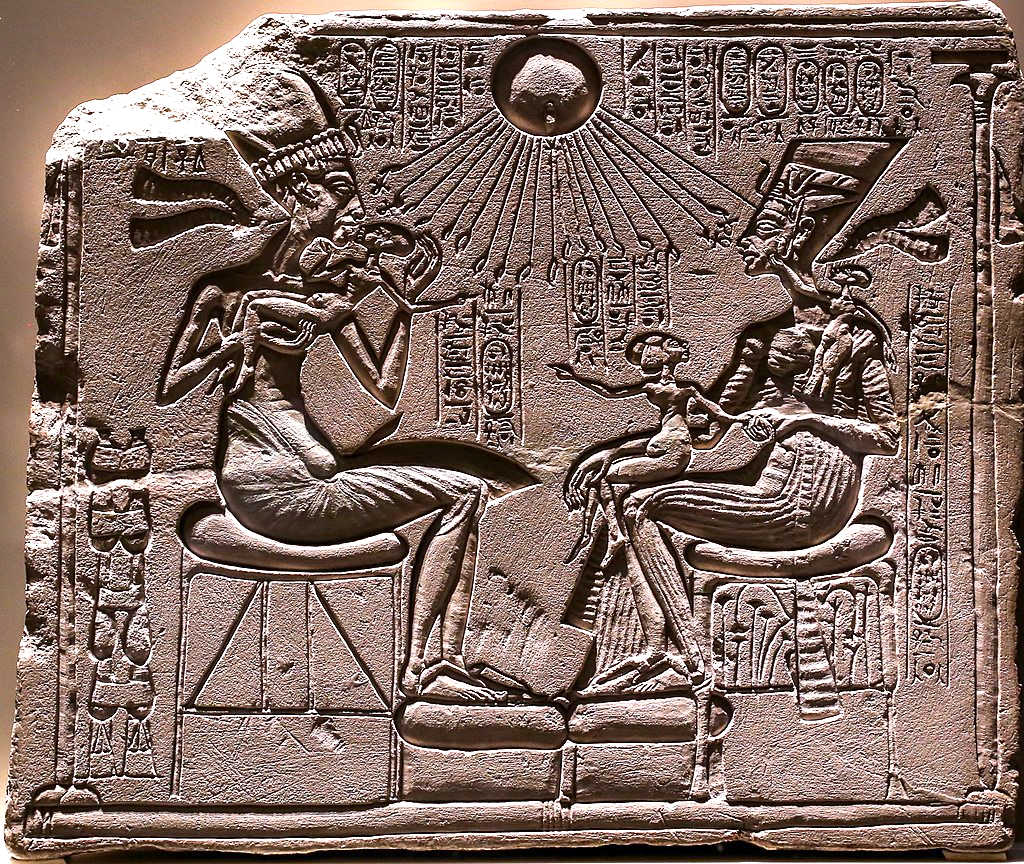
A
stone relief showing Akhenaten and his wife Nefertiti with
three of their daughters
LEGACY
With Akhenaten's death, the Aten cult he had founded fell out of favor: at first gradually, and then with decisive finality. Tutankhaten changed his name to
Tutankhamun
in Year 2 of his reign (c. 1332 BC) and abandoned the city of Akhetaten. Their successors then attempted to erase Akhenaten and his family from the historical record. During the reign of Horemheb, the last pharaoh of the Eighteenth Dynasty and the first pharaoh after Akhenaten who was not related to Akhenaten's family, Egyptians started to destroy temples to the Aten and reuse the building blocks in new construction projects, including in temples for the newly restored god Amun. Horemheb's successor continued in this effort. Seti I restored monuments to
Amun
and had the god's name re-carved on inscriptions where it was removed by Akhenaten. Seti I also ordered that Akhenaten, Smenkhkare, Neferneferuaten, Tutankhamun, and Ay be excised from official lists of pharaohs to make it appear that Amenhotep III was immediately succeeded by Horemheb. Under the Ramessides, who succeeded Seti I, Akhetaten was gradually destroyed and the building material reused across the country, such as in constructions at Hermopolis. The negative attitudes toward Akhenaten were illustrated by, for example, inscriptions in the tomb of scribe Mose (or Mes), where Akhenaten's reign is referred to as "the time of the enemy of Akhet-Aten."
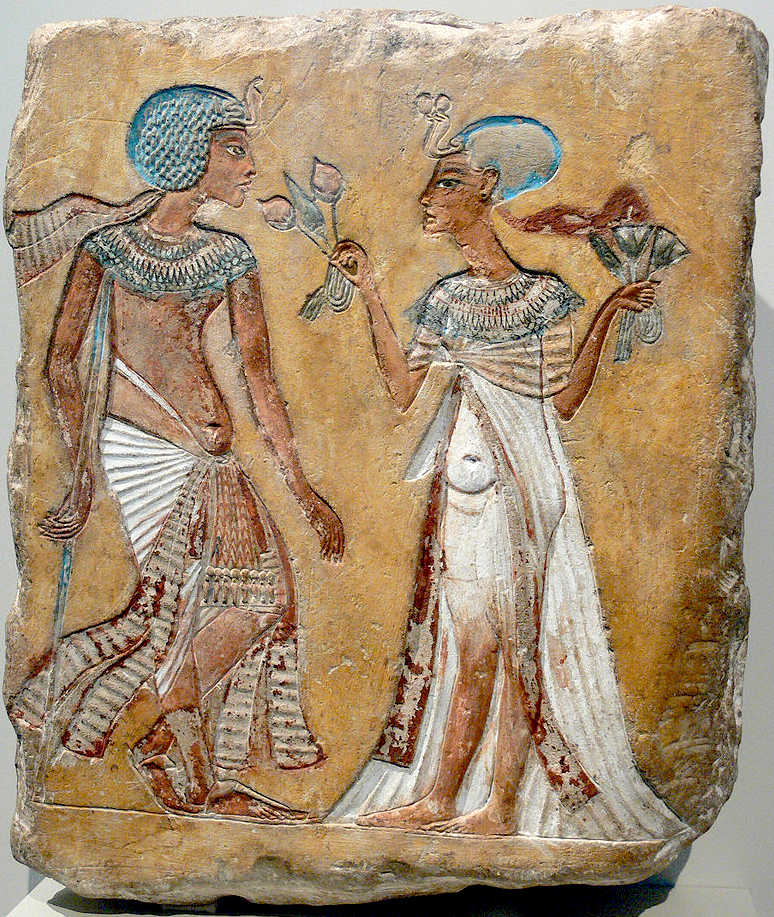
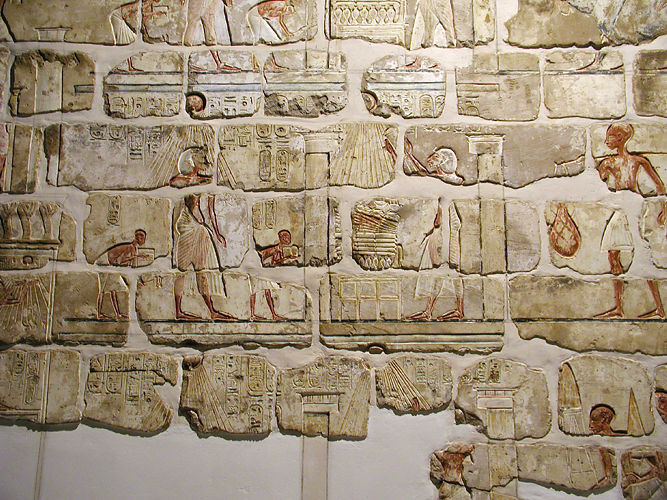
Temple
tablet relief's called talatats
ATENISM
Egyptians worshipped a sun god under several names, and solar worship had been growing in popularity even before Akhenaten, especially during the Eighteenth Dynasty and the reign of Amenhotep III, Akhenaten's father. During the New Kingdom, the pharaoh started to be associated with the sun disc; for example, one inscription called the pharaoh Hatshepsut the "female Re shining like the Disc," while Amenhotep III was described as "he who rises over every foreign land, Nebmare, the dazzling disc." During the Eighteenth Dynasty, a religious hymn to the sun also appeared and became popular among Egyptians. However, Egyptologists question whether there is a causal relationship between the cult of the sun disc before Akhenaten and Akhenaten's religious policies.
The implementation of Atenism can be traced through gradual changes in the Aten's iconography, and Egyptologist Donald B. Redford divided its development into three
stages - earliest, intermediate, and final - in his studies of Akhenaten and Atenism. The earliest stage was associated with a growing number of depictions of the sun disc, though the disc is still seen resting on the head of the falcon-headed sun god Ra-Horakhty, as the god was traditionally represented. The god was only "unique but not exclusive." The intermediate stage was marked by the elevation of the Aten above other gods and the appearance of cartouches around his inscribed
name - cartouches traditionally indicating that the enclosed text is a royal name. The final stage had the Aten represented as a sun disc with sunrays like long arms terminating in human hands and the introduction of a new epithet for the god: "the great living Disc which is in jubilee, lord of heaven and earth."
In the early years of his reign, Amenhotep IV lived at Thebes, the old capital city, and permitted worship of
Egypt's traditional deities to continue. However, some signs already pointed to the growing importance of the Aten. For example, inscriptions in the Theban tomb of Parennefer from the early rule of Amenhotep IV state that "one measures the payments to every (other) god with a level measure, but for the Aten one measures so that it overflows," indicating a more favorable attitude to the cult of Aten than the other gods. Additionally, near the Temple of Karnak, Amun-Ra's great cult center, Amenhotep IV erected several massive buildings including temples to the Aten. The new Aten temples had no roof and the god was thus worshipped in the sunlight, under the open sky, rather than in dark temple enclosures as had been the previous custom. The Theban buildings were later dismantled by his successors and used as infill for new constructions in the Temple of Karnak; when they were later dismantled by archaeologists, some 36,000 decorated blocks from the original Aten building here were revealed that preserve many elements of the original relief scenes and inscriptions.
One of the most important turning points in the early reign of Amenhotep IV is a speech given by the pharaoh at the beginning of his second regnal year. A copy of the speech survives on one of the pylons at the Karnak Temple Complex near Thebes. Speaking to the royal court, scribes or the people, Amenhotep IV said that the gods were ineffective and had ceased their movements, and that their temples had collapsed. The pharaoh contrasted this with the only remaining god, the sun disc Aten, who continued to move and exist forever. Some Egyptologists, such as Donald B. Redford, compared this speech to a proclamation or manifesto, which foreshadowed and explained the pharaoh's later religious reforms centered around the Aten. In his speech, Akhenaten said:
" The temples of the gods fallen to ruin, their bodies do not endure. Since the time of the ancestors, it is the wise man that knows these things. Behold, I, the king, am speaking so that I might inform you concerning the appearances of the gods. I know their temples, and I am versed in the writings, specifically, the inventory of their primeval bodies. And I have watched as they [the gods] have ceased their appearances, one after the other. All of them have stopped, except the god who gave birth to himself. And no one knows the mystery of how he performs his tasks. This god goes where he pleases and no one else knows his going. I approach him, the things which he has made. How exalted they are."

In Year Five of his reign, Amenhotep IV took decisive steps to establish the Aten as the sole god of Egypt. The pharaoh "disbanded the priesthoods of all the other gods ... and diverted the income from these [other] cults to support the Aten." To emphasize his complete allegiance to the Aten, the king officially changed his name from Amenhotep IV to Akhenaten (Ancient Egyptian: ꜣḫ-n-jtn, meaning "Effective for the Aten"). Meanwhile, the Aten was becoming a king itself. Artists started to depict him with the trappings of pharaohs, placing his name in
cartouches ó a rare, but not unique occurrence, as the names of Ra-Horakhty and Amun-Ra had also been found enclosed in cartouches ó and wearing a uraeus, a symbol of kingship. The Aten may also have been the subject of Akhenaten's royal Sed festival early in the pharaoh's reign. With Aten becoming a sole deity, Akhenaten started to proclaim himself as the only intermediary between Aten and his people, and the subject of their personal worship and attention ó a feature not unheard of in Egyptian history, with Fifth Dynasty pharaohs such as Nyuserre Ini proclaiming to be sole intermediaries between the people and the gods Osiris and Ra.
By Year Nine of his reign, Akhenaten declared that Aten was not merely the supreme god, but the only worshipable god. He ordered the defacing of Amun's temples throughout Egypt and, in a number of instances, inscriptions of the plural 'gods' were also removed. This emphasized the changes encouraged by the new regime, which included a ban on images, with the exception of a rayed solar disc, in which the rays appear to represent the unseen spirit of Aten, who by then was evidently considered not merely a sun god, but rather a universal deity. All life on Earth depended on the Aten and the visible sunlight. Representations of the Aten were always accompanied with a sort of hieroglyphic footnote, stating that the representation of the sun as all-encompassing creator was to be taken as just that: a representation of something that, by its very nature as something transcending creation, cannot be fully or adequately represented by any one part of that creation. Aten's name was also written differently starting as early as Year Eight or as late as Year Fourteen, according to some historians. From "Living Re-Horakhty, who rejoices in the horizon in his name Shu-Re who is in Aten," the god's name changed to "Living Re, ruler of the horizon, who rejoices in his name of Re the father who has returned as Aten," removing the Aten's connection to Re-Horakhty and Shu, two other solar deities. The Aten thus became an amalgamation that incorporated the attributes and beliefs around Re-Horakhty, universal sun god, and Shu, god of the sky and manifestation of the sunlight.
Akhenaten's Atenist beliefs are best distilled in the Great Hymn to the Aten. The hymn was discovered in the tomb of Ay, one of Akhenaten's successors, though Egyptologists believe that it could have been composed by Akhenaten himself. The hymn celebrates the sun and daylight and recounts the dangers that abound when the sun sets. It tells of the Aten as a sole god and the creator of all life, who recreates life every day at sunrise, and on whom everything on Earth depends, including the natural world, people's lives, and even trade and commerce. In one passage, the hymn declares: "O Sole God beside whom there is none! You made the earth as you wished, you
alone." The hymn also states that Akhenaten is the only intermediary between the god and Egyptians, and the only one who can understand the Aten: "You are in my heart, and there is none who knows you except your son."
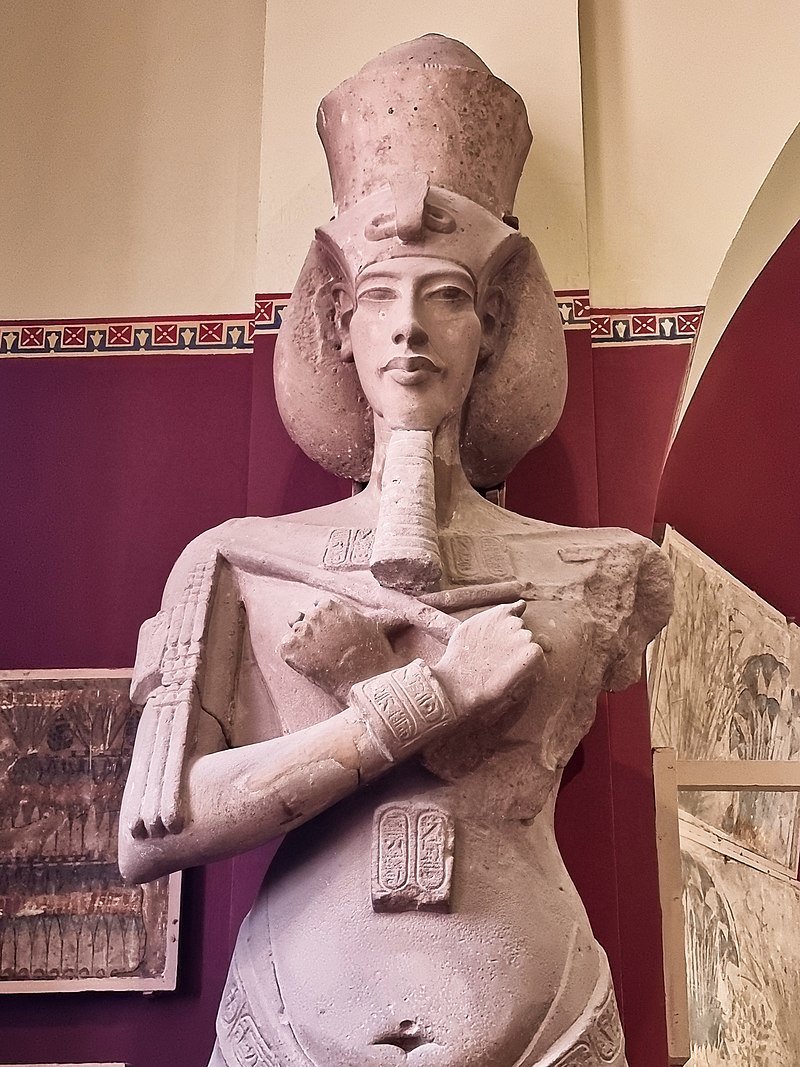
A
bust of Akhenaten, showing his elongated head as a feature
NOTABLE KINGS
Djoser
Khufu
Khafre
Ahmose
Amenhotp I
Thutmose I, II, III
Ramesses I, II III, VI, VIII, IX, X, XI
Amenhotep II
Akhenaten
Tutankamun
Seti I & II
Alexander the Great
Ptolemy I Soter I
Ptolemy IV Philopator
Ptolemy VI Philometor
Ptolemy IX Soter II
NOTABLE QUEENS
Arsinoe II
Cleopatra I, II
Hatshepsut
Sobekneferu
(Neferusobek)
Nefertiti,
beautiful ancient Egyptian queen, architect of the sun cult
Cleopatra
VII
last queen of Egypt
Amina, queen for 34 years in Nigeria
Candace,
Ethiopian Empress, fearsome fighter who resisted Alexander the
Great
Semiramis,
female ruler Assyrian empire.
REFERENCE
https://www.
CLEOPATRA
THE MUMMY
'Cleopatra
- The Mummy' is an original story in the John Storm franchise (for which a
draft
script is published for studios, producers and directors). The
John Storm
franchise is a series of
ocean awareness adventures, featuring the incredible solar
powered trimaran: Elizabeth
Swann.